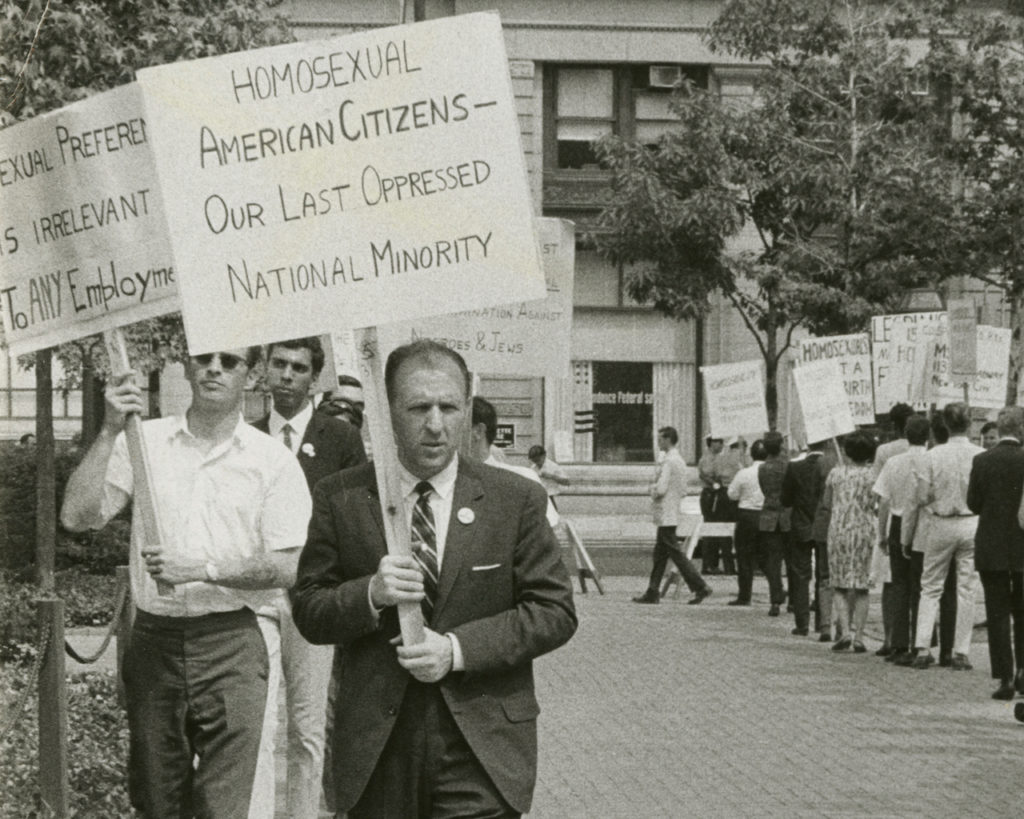
Frank Kameny leads a picket line in front of Independence Hall in Philadelphia on July 4, 1965, four years before the Stonewall uprising in New York City. Kameny, who served in World War II and later as a civil service astronomer with the U.S. Army’s Map Service, was fired and banned from federal employment in 1957 because he was gay. Photo: New York Public Library.
Many LGBTQ+ people who served their country had to do it in silence. They faced a hostile environment where they feared being court martialed, dishonorably discharged, or worse.
In December 2010, the Don’t Ask, Don’t Tell Repeal Act of 2010 created a complicated pathway for gays and lesbians to openly serve in the military.
According to the bill, the “Don’t ask, don’t tell” policy remained in place until the president, the secretary of defense, and the chairman of the joint chiefs certified that the repeal wouldn’t harm military readiness, followed by a 60-day waiting period.
A court order on July 6, 2011, ordered the Pentagon to immediately suspend the ban. The repeal finally took effect Sept. 20, 2011.
Gays, lesbians who served during World War II found freedom, were persecuted
On Memorial Day, we honor the LGBTQ+ individuals who died fighting for their country alongside their heterosexual, cisgender service members.
Queer 40 compiled a list of LGBTQ+ service members who deserve to be acknowledged, remembered, and thanked on Memorial Day and everyday.
Here are three of them, but please check out the full article.
Fannie Mae Clackum
Fannie Mae Clackum and Grace Garner worked together as Air Force reservists. In 1951, the Office of Special Investigations examined the Air Force’s suspicions that Clackum and Garner were lesbians in a through a sting operation. Later that year, Clackum was told that some action was being contemplated against her and was offered the chance to resign. She refused and requested a trial by court-martial to force the Air Force to provide information on the accusations against her and allow her to present evidence on her own behalf. Clackum’s request was denied. In January 1952, Clackum and Garner were demoted and discharged under less than honorable conditions.
The two women, who reportedly lived together in Georgia, spent eight years fighting their discharges. In 1960, Clackum and Garner prevailed in the U.S. Court of Claims; their discharges were invalidated. They received all back pay for the remainder of their enlistments. The court found it “unthinkable” that the Air Force would burden them with undesirable discharges “without respect for even the most elementary notions of due process of law.” While their cases were overturned because the Air Force kept Clackum and Garner unaware of the allegations and proceedings prior to their discharges thereby denying them due process, their cases are among the earliest known instances of successful appeals of discharges from the U.S. Armed Forces on grounds of homosexuality. Clackum died in 2014.
Frank E. Kameny
Frank E. Kameny, who served in World War II and later as a civil service astronomer with the U.S. Army’s Map Service, was fired and banned from federal employment in 1957 because he was gay. He was not alone. More than 10,000 LGBTQ+ workers were forced from their jobs during the 1950s and 60s, a period known as the “Lavender Scare.” Kameny decided to sue, but lost. He tried to appeal, but lost again. He continued, bringing the first civil rights action suit regarding sexual orientation to the U.S. Supreme Court. Kameny argued that the government’s actions toward the LGBTQ+ community were, in his words, “an affront to human dignity.” Still, the court denied his petition.
Kameny continued to fight for civil rights for 18 more years, until the Civil Service Commission reversed its policies that excluded homosexuals from government employment. In 2007, 50 years after he was fired from his job, Kameny received a formal apology for being fired based solely on his sexual orientation. Kameny is considered one of the most significant figures in the gay civil rights movement. Kameny passed away in 2011.
Leonard P. Matlovich
Leonard P. Matlovich, a Vietnam War veteran, earned a Purple Heart and Bronze Star for his service. In 1974, he was also the first gay service member to purposely out himself to challenge the ban against gays in the military, and he fought to remain in the Air Force after coming out. Numerous TV interviews, newspaper articles, and an NBC television movie followed, as did the cover of Time magazine in 1975. Matlovich sued for reinstatement, but the legal process was a long one, with the case moving back and forth between district and circuit courts.
By September 1980, the Air Force had failed to give federal Judge Gerhard Gesell an explanation of why Matlovich didn’t meet its criteria for exception, and Gesell ordered him reinstated and promoted. The Air Force offered Matlovich a financial settlement instead. Matlovich accepted because he thought the military would find another reason to discharge him if he re-entered the service, or that the conservative Supreme Court would rule against him should the Air Force appeal. He died in 1988. Matlovich’s epitaph reads, “When I was in the military they gave me a medal for killing two men and a discharge for loving one.”
